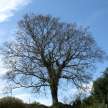Stone Piled Upon Stone
The Folklore of Brentor

It’s said that the devil was not best pleased with the prospect of a church on Brentor. Such was his objection that it took a truly angelic presence, no less than St. Michael of the Rock to assuage his resistance. Of course, the likelihood of St. Michael making an appearance on that barren hillside was as great, as or as small, as the sudden intervention of the devil. In fact, given the number of appearances the devil was credited with right across Dartmoor, the presence of Archangel Michael, the warrior saint, might be presumed to be less likely. Which is not to say that there wasn’t some kind of altercation between those who wanted to build a church on the hill and those others, that nameless and numberless remainder, who disagreed.
If there was some kind of dispute — and the folklore hints at the possibility — it suggests that, prior to 1130, Brentor held some significance in the landscape. The nature of the tor, an outlying pinnacle of granite towering above the green fields west of Dartmoor, arguably creates its own significance. It was a place to see from, just as much as it was a place to be seen. There’s certainly a good argument for its use as a beacon along a chain of likely sites including Kit Hill to the south west and Yes Tor, a straight line in the other direction.
That’s logical for sure. One not so logical, but certainly compelling explanation, is that Brentor sits on an important ley line. Michael’s Line (or derivatives of that name), follows St. Michael associated points along a route, stretching from St. Michael’s Mount off the Cornish Coast all the way in a straight line, through Kit Hill, Brentor, Yes Tor and onwards, not forgetting, if you’re willing to take brief diversions, Lydford Castle, and the Nine Maidens.
Old Straight Tracks. What are we to make of them? Well, to be sure, we can be literal. Devon roads are not, it will be agreed, ordinarily laid down in straight lines. It’s a curvy place, Devon. Well that’s not the case in an around Brentor. Take a look at a map, starting with the road that skirts round the tor connecting Tavistock to Lydford and there’s more than just that one. The way these roads surge across the landscape, their width, how hedge lines take their cue from them — all this suggests they are old and were laid down before the rural order that now prevails. But however much they seem to dominate the landscape, they still conform to Brentor, bending round the hill, following, or followed by, circles of fields at the base.
To say that these roads conform to the idea of a ley line is certainly pushing it. If there were but one and it pointed straight at Kit Hill or Yes Tor, then perhaps a case might be made, but these roads don’t conform to anything but their own purpose and the need to avoid the slopes of Brentor. Are they Roman roads? Until recently, that would have been a leap in archaeological terms because it was generally believed that Roman Britain didn’t make too much of an effort past Exeter. However, the discovery of Roman forts at Calstock and Restormel, shows that, even in the early centuries, they were certainly active — most likely mining and trading, all along the South West peninsular.
Intriguingly, along that road to Tavistock is Hurdwick Farm. There’s also a golf course and a quarry, both of which use that name. The placename is first mentioned in historical documents back in 1275. Often the "wick" element of a name suggests an earlier settlement or farm (it’s derived from Vicus) that might date back to Roman times. Evidence of settlement in and around Tavistock before the establishment of the Abbey in 961 is provided by three post-Roman grave markers that are currently kept in the garden of Tavistock Vicarage.
All that said, the more likely proposition is that these old straight roads were laid out once Tavistock was given the status of a Stannary Town. The roads would have been widened and straightened to ease traffic and speed goods moving from the Dartmoor mines down to trading posts on the Tamar or on the coast at Plymouth. If it was Stannary related, it gives an indications of the powers that harboured; widening and straightening roads involves using land which is owned by somebody else and, checking the map, you’ll see that these roads stop for no-one.

Photo Credit: Simon Ward
None of this is proof of anything except the rather obvious point that Brentor, perhaps more than any other landmark in the immediate vicinity, has played a crucial part in the lives of people going back to the Roman times and well before. What it was called and how it was used are open to investigation, but it can be imagined that such a towering mass of rock, apparently dumped a good few miles from its natural habitat on the moor, would have, at the least, raised Bronze Age eyebrows.
Which makes sense; Dartmoor, that erupted granite mass, was created around 300 million years ago. In other words, Brentor has been in the landscape longer than the presence of man. It has, through countless generations and quite possibly a collection of different tribes, been viewed, used, feared and revered for the entire stretch of time in which the immediate countryside has been occupied, transgressed or traversed. The few thousand years that we can account for in historical terms, not to mention the pre-historical eternity that preceded it, are but a small part of Brentor’s existence.
However it was viewed and whatever its use, it was, before Rome came, important enough to enclose. The peculiar rampart that prevents easy entry from the north and east, apparently ditchless, and unusually sited at the base of the essential hill, must have been a significant community effort. And just as building a church atop the tor had fashioned its own mythology, imagine, if you will, what other mythologies and folklore were associated with the site for the two millennia prior to St Michael’s appearance. Perhaps it was already dedicated. To whom or what is difficult to say, but you can certainly imagine the consternation that might have resulted from the decision to build a church high upon the stones.
In all communities, fashions and beliefs, even if they fade out after a few years, or the odd millennia, have a way of making their mark. St. Michael de Rupe, sitting atop Brentor, graces the landscape, stone piled upon stone, but which will last the longest?
About the Creator
Simon Ward
Freelance writer and editor, currently itinerant.






Comments
There are no comments for this story
Be the first to respond and start the conversation.